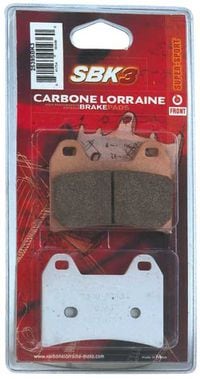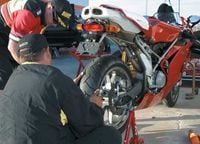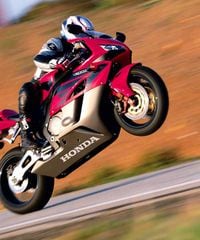Making your bike perform better doesn't have to cost a ton of money. In fact, there are ways you can improve you motorcycle that don't cost a penny. Here are ten good tweaks that aren't wallet-busters...plus a free bonus freebie.
Tweak #1: Adjust your bike's suspension settings to your weight and riding style
Cost: Zero (OK, maybe a beer for the friend who helps you do this)
Benefit: Improved ride quality and road-holding ability
Although many of us wish we weighed 150 pounds (the generic weight most manufacturers use to set stock suspensions), most of us fall to one side of that magic number, requiring a suspension adjustment to ensure that our bike handles properly. Bikes offer varying amounts of adjustability, but most at least have preload adjustment for setting laden sag (the amount the suspension compresses under rider weight) to keep the suspension in the sweet spot during normal riding. The procedure goes like this: Take a measurement with the bike's suspension at full extension (topped out), and then another measurement with you aboard in full regalia. At the front, measure along a fork leg, and at the rear measure between the axle and some convenient bit of bodywork directly above the axle line. The difference in distance from topped-out to laden (by the rider) is the sag. You're shooting for 25mm to 35mmless for sportier handling, more for increased comfort. Sophisticated bikes also offer adjustments for rebound and/or compression damping. Check your owner's manual for how to make the changes and what the baseline settings should be. Make one change at a time and stop fiddling when the bike feels good to you.
Tweak #2: Fork upgrades such as Cartridge Emulators from Race Tech, stiffer springs
Cost: $100-$180
Benefit: Optimized suspension performance calibrated specifically to your riding style
The biggest performance handicap on a budget bike? Probably the bargain-basement damper-rod forks, such as those fitted to the 599, FZ6 and SV650 and most other low- to midpriced motorcycles. Because of compromises, they can be harsh over small bumps yet too soft when confronted with big hits. There is cheap help, though; scratch together 150-odd buckaroos for a set of Race Tech's Gold Valve Cartridge Emulators, tunable valves that make a damper-rod fork act like a shim-equipped cartridge fork. Installing emulators calls for complete fork disassembly—you must enlarge the old compression-damping holes (negating their effect) and may have to cut new preload spacers. While you're in there, consider different springs for a firmer ride; many budget bikes are quite undersprung in anticipation of light riders and modest scratchin'. Race Tech has a nice online calculator to help you find the proper spring rates.
Tweak #3: Upgraded brake pads and lines
Cost: $30-$50 (pads, per pair), $80-$100 (lines)
Benefit: Improved brake feel, less fade, shorter stopping distances
Each year more new bikes arrive from the factory with HH-rated pads and braided stainless steel "hard" brake lines for optimum braking performance. Braided stainless steel or Kevlar-sheathed Teflon lines resist deformation under system pressure for quicker braking response and firm, mush-free lever feel. If your bike isn't already equipped with these, make the upgrade. Quality aftermarket pads use specially formulated compounds to better bite rotors and hold on longer with less fade. If less than 2mm of your existing pad material remains or the pads are worn past the groove in the face, chuck 'em and get good ones. And don't forget to flush and replace the fluid while you're at it. You'll be amazed at the improvement.
Tweak #4: Wash and wax your bike
Cost: Nada
Benefit: Looks better, lasts longer, helps you identify problems early before they become expensive nightmares
OK, so you have to pay for some soap and water, but you'd be surprised how far a regular wash and wax goes toward protecting your ride. Suds chase dirt and contaminants offprotecting paint from scratches and chrome and aluminum from discoloration and damage—and flush abrasive agents away from such sensitive surfaces as fork legs and swingarm pivots. A good wash and wax also lets you inspect your bike up close to catch any emergent mechanical maladies before they develop into serious problems. Things to keep an eye on while scrubbing: tire-tread wear, tire pressure, chain slack, sprocket wear, oil level, brake-pad thickness, brake mounting bolts, axle adjusters and brake and shift linkages. Don't forget to give your chain a good shot of lube when you're done.
Tweak #5: Replace your tires
Cost: $200-$300
Benefit: Better traction, improved handling, safety
Nothing brings back that new-bike feeling like new tires. Uneven wear (front-tire cupping, squaring off at the rear) means your tires can be junk well before you hit the wear bars. Even when you're not riding your bike, UV light can substantially reduce tire life, so you should replace your rubber every few years regardless of miles. Tire technology has made some radical advances in recent years; if you haven't had new skins since the 1990s you'll be amazed how much a new set will improve your bike's performance. Even sport-touring tires are sticky enough for aggressive street riders.
Tweak #6: Frame sliders
Cost: $50-$100
Benefit: Protect your plastic in the event of a tip-over
Conventional wisdom says sportbikes are so expensive to insure because they are so gawd-awful fast. This statement is partially true, but outrageous premiums are more often related to the fact that sportbikes are so easily damaged. Even dropping your bike in the garage can easily result in thousands of dollars of busted plastic and scratched paint—and a big insurance claim. The best insurance against this is bolting on a set of frame sliders: small plastic or metal bumpers that bolt to the motorcycle frame and save expensive fairing bits—and levers, pegs, turn signals, mirrors, anything else that sticks out—from being fouled in a tip-over or crash. Plenty of colors, shapes and sizes are available (even some that light up!), and every last one is cheaper than even one piece of OEM plastic.
Tweak #7: Regear your motorcycle
Cost: $20-$100
Benefit: A cheap way to quicker acceleration
Explained in detail in our June 2003 issue ("Torque Is Cheap"), shortening your bike's overall gearing can be an easy and inexpensive path to quicker acceleration. This change will come at the expense of a bit of top speed, but what's more routinetrying to outrun an SUV bumbling into your lane or trying to nudge the needle over 170 mph? (We thought so.) A slight changeExplained in detail in our June 2003 issue ("Torque Is Cheap"), shortening your bike's overall gearing can be an easy and inexpensive path to quicker acceleration. This change will come at the expense of a bit of top speed, but what's more routinetrying to outrun an SUV bumbling into your lane or trying to nudge the needle over 170 mph? (We thought so.) A slight change>Explained in detail in our June 2003 issue ("Torque Is Cheap"), shortening your bike's overall gearing can be an easy and inexpensive path to quicker acceleration. This change will come at the expense of a bit of top speed, but what's more routinetrying to outrun an SUV bumbling into your lane or trying to nudge the needle over 170 mph? (We thought so.) A slight changexplained in detail in our June 2003 issue ("Torque Is Cheap"), shortening your bike's overall gearing can be an easy and inexpensive path to quicker acceleration. This change will come at the expense of a bit of top speed, but what's more routine—trying to outrun an SUV bumbling into your lane or trying to nudge the needle over 170 mph? (We thought so.) A slight change—down one tooth on the countershaft sprocket or up three on the rear sprocket—can often be made without lengthening or replacing the chain, but consider springing for a new chain anyway; a worn chain can greatly accelerate wear on your nice new sprocket. This mod does come with some hidden costs: Your engine will spin faster in any given gear, which can increase vibration, and if your bike's speedo pickup is on the transmission or countershaft sprocket, accuracy will be affected. But if you're looking for the cheapest and easiest path to faster acceleration, regearing is hard to beat.
Tweak #8: Read a book
Cost: $20-$40 (less if you're nice to the librarian)
Benefit: Become a better rider, wrench, or both
We're always extolling the virtues of attending advanced riding schools, such as the California Superbike School or CLASS, but let's face it—with entry fees of several hundred dollars, these are hardly low-buck ventures. Although it's no replacement for real-time, one-on-one instruction from acknowledged experts, reading a good riding-skills handbook like Nick Ienatsch's Sport Riding Techniques ($24.95 from David Bull Publishing, 800/831-1758) can teach you an awful lot of valuable riding techniques you can practice on your own each time you ride. Similarly, a good maintenance manual to guide you through simple maintenance procedures (replacing fork seals, adjusting steering-head bearings, etc.) can deliver you from $70-per-hour dealer labor rates. On this front, Mark Zimmerman's excellent, 255-page, full-color The Essential Guide to Motorcycle Maintenance ($29.95, Whitehorse Press), is the best one we've seen yet.
Tweak #9: Replace your helmet
Cost: $150-$500
Benefit: Cooler, quieter, more comfort—and cranium protection, too
Helmet manufacturers recommend replacing your helmet at least every four years regardless of appearance the integrity of the protective polystyrene inner lining, it seems, degrades with exposure to the atmosphere and UV rays. Helmets also start fitting funkily as the inner resilient liner compresses with use, not to mention a different sort of funk from the hours of close contact with your sweaty scalp. Do yourself a favor and upgrade your headgear to a more modern piece. Like tires, helmets have made startling advances in the past few years, with space-age shell materials making them lighter than ever. With improved ventilation and sound deadening, even today's budget lids send yesterday's top-line buckets to the wastebasket. There is no piece of motorcycle gear you are more intimate with, and none more directly related to your safety and comfort. A good helmet is money well spent.
Tweak #10: Antifog for pennies a day
Cost: Zip-$24
Benefit: No more vision-robbing vapor
Steal a trick from our scuba-diving friends: Once you get that new helmet, pull off the visor and spit all over the inside of it. Wipe the saliva off with a clean, soft rag and voila, instant antifog coating! Don't like the spit smell? Shaving cream or toothpaste rubbed on the visor and wiped off has a similar no-buck antifog effect. If you absolutely have to spend money, a variety of inexpensive antifog solutions are available at most decent bike shops—our favorite is the oddly named but highly effective Cat Crap for a measly $3.99. Big spenders should check out Fog City Pro Shield's antifog shield inserts (www.modernworld.com), which sell for $17 (tinted) or $30 (photosensitive). All are cheap, effective and loads safer than stuffing your fingers up behind the chin bar to wipe the shield on the road.
BONUS Tweak: Ride your bike
Cost: Nothin' but fuel Benefit: Keeps your bike working well, improves your 'tude
Just like the human body, your motorcycle responds favorably to regular exercise to keep the carbs from clogging, the tires from calcifying, the battery from prematurely discharging, the cylinder walls from corroding, and any other myriad minor maladies from afflicting seldom-used streetbikes. Do yourself and your bike a huge favor and go ride the wheels off it. That's our best advice yet.

















/cloudfront-us-east-1.images.arcpublishing.com/octane/HXOUJXQWA5HBHGRO3EMJIGFMVI.jpg)

/cloudfront-us-east-1.images.arcpublishing.com/octane/3TIWWRV4JBBOLDVGRYECVVTA7Y.jpg)
/cloudfront-us-east-1.images.arcpublishing.com/octane/KIX5O23D5NAIBGFXBN3327DKZU.jpg)
/cloudfront-us-east-1.images.arcpublishing.com/octane/7GJYDUIPXRGMTMQKN6ONYOLBOU.jpg)
/cloudfront-us-east-1.images.arcpublishing.com/octane/MUQLOVLL2ZDGFH25ILABNBXKTI.jpg)
/cloudfront-us-east-1.images.arcpublishing.com/octane/TNOU5DNE2BC57MFPMGN2EIDXAM.jpg)
/cloudfront-us-east-1.images.arcpublishing.com/octane/GTCXACQGJ5HAPDTGWUQKDEH44E.jpg)
/cloudfront-us-east-1.images.arcpublishing.com/octane/S35YGSEMEZB4BLTDJTSZPF4GLA.jpg)
/cloudfront-us-east-1.images.arcpublishing.com/octane/5UOT6HPX2JFMRJAX6EH45AR4MQ.jpg)
/cloudfront-us-east-1.images.arcpublishing.com/octane/OKWOJWAKP5EP3OACCRRWPCIX2Q.jpg)
/cloudfront-us-east-1.images.arcpublishing.com/octane/2WF3SCE3NFBQXLDNJM7KMXA45E.jpg)
/cloudfront-us-east-1.images.arcpublishing.com/octane/G4MG6OUCJNBSHIS2MVVOTPX65E.jpg)
/cloudfront-us-east-1.images.arcpublishing.com/octane/IIGGWFOTOJGB7DB6DGBXCCMTDY.jpg)
/cloudfront-us-east-1.images.arcpublishing.com/octane/QSTCM6AVEZA5JJBUXNIQ3DSOF4.jpg)
/cloudfront-us-east-1.images.arcpublishing.com/octane/U4I7G625B5DMLF2DVIJDFZVV6M.jpg)
/cloudfront-us-east-1.images.arcpublishing.com/octane/B6XD6LS6IVCQPIU6HXDJSM3FHY.jpg)
/cloudfront-us-east-1.images.arcpublishing.com/octane/ICL63FEDDRDTTMINYICCEYGMDA.jpg)
/cloudfront-us-east-1.images.arcpublishing.com/octane/FCGZHQXRBZFLBAPC5SDIQLVF4I.jpg)
/cloudfront-us-east-1.images.arcpublishing.com/octane/WNOB6LDOIFFHJKPSVIWDYUGOPM.jpg)

/cloudfront-us-east-1.images.arcpublishing.com/octane/X33NU3E525ECRHXLNUJN2FTRKI.jpg)
/cloudfront-us-east-1.images.arcpublishing.com/octane/6KKT5NNL2JAVBOXMZYS5ZO76YA.jpg)
/cloudfront-us-east-1.images.arcpublishing.com/octane/J5RKG5O455GMPGQRF2OG6LRT7A.jpg)